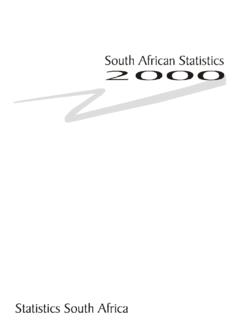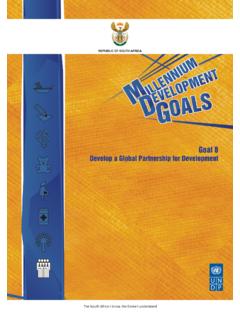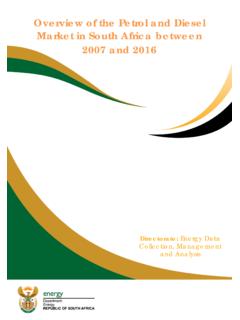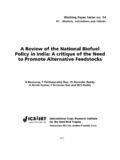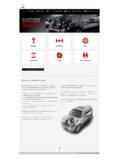Transcription of DISCUSSION DOCUMENT ON SOUTH AFRICA’S MOTOR …
1 THE SOUTH africa I KNOW, THE HOME I UNDERSTAND DISCUSSION DOCUMENT ON SOUTH africa S MOTOR TRADE INDUSTRY DISCUSSION DOCUMENT : February 2018 STATISTICS SOUTH africa 2 TABLE OF CONTENTS 1. INTRODUCTION .. 4 2. OVERVIEW OF THE MOTOR TRADE INDUSTRY .. 4 3. THE STRUCTURE OF THE MOTOR TRADE INDUSTRY .. 5 Market structure .. 5 Income contribution .. 7 The profit margin .. 8 Expenditure structure .. 8 4. RETAIL SALES OF MOTOR VEHICLES .. 11 Economic performance .. 13 Prices .. 14 Production volumes and exchange rates .. 15 5. RETAIL SALES OF AUTOMOTIVE FUEL .. 17 Price and consumption of fuel .. 19 Convenience stores .. 20 6. EMPLOYMENT IN THE MOTOR TRADE INDUSTRY .. 20 Employment by type of MOTOR trade .. 20 Employment by gender .. 21 Employment by enterprise 22 Employment by type of contract .. 22 Income share, employment share and average earnings.
2 23 7. CONCLUSION .. 24 APPENDIX .. 25 STATISTICS SOUTH africa 3 LIST OF TABLES Table 1 Concentration ratios (five largest) in the MOTOR trade industry, 2006 2015 .. 6 Table 2 Income contribution by MOTOR trade type (percentage), 2006 2015 .. 7 Table 3 Employment by enterprise size (percentage contribution), 2015 .. 22 Table 4 Income share, employment share and average earnings by MOTOR trade type, 2015 .. 23 LIST OF FIGURES Figure 1 Real GDP and MOTOR trade value added growth rates, 2005 2015 .. 5 Figure 2 Income contribution by enterprise size (percentage), 2006 2015 .. 7 Figure 3 Profit margins by MOTOR trade type (percentage), 2006 2015 .. 8 Figure 4 Expenditure in the MOTOR trade industry, 2006 2015 .. 9 Figure 5 Capital expenditure on new assets by type of service, 2006 2015 .. 10 Figure 6 Capital expenditure by type of asset, 2006 2015 .. 11 Figure 7 Income contribution of retail sales of MOTOR vehicles, 2006 2015.
3 12 Figure 8 Income from sales by type of MOTOR vehicle, 2006 2015 .. 12 Figure 9 Sales of MOTOR vehicles; parts and accessories, 2006 2016 .. 13 Figure 10 Real GDP growth for SOUTH africa , 2004 2016 .. 14 Figure 11 Household consumption expenditure, 2004 2016 .. 14 Figure 12 Headline inflation and new vehicle price, 2005 2016 .. 15 Figure 13 Headline inflation and price of petrol, 2005 2016 .. 15 Figure 14 MOTOR vehicle volume of production and foreign trade, 2005 2016 .. 16 Figure 15 Rand/US dollar exchange rate, 2005 2016 .. 16 Figure 16 Income contribution for retail sales of automotive fuel, 2006 2015 .. 17 Figure 17 Income from retail sales of petrol and diesel, 2006 18 Figure 18 Income from total sales of trucks and lorries, 2006 18 Figure 19 Headline CPI, petrol and diesel price index, 2005 2016 .. 19 Figure 20 Volume of petrol and diesel consumed (litres), 2005 2016 .. 19 Figure 21 Income from convenience store sales, 2006 2016.
4 20 Figure 22 Employment by type of MOTOR trade (percentage of total), 2015 .. 21 Figure 23 Employment by gender (percentage of total), 2015 .. 21 Figure 24 Employment by type of contract (percentage of total), 2015 .. 23 STATISTICS SOUTH africa 4 1. INTRODUCTION MOTOR trade is a dynamic industry which can experience rapid change in a short space of time. Growth in this industry is largely explained by the nature of competition and changing consumer demands. Thus, today s MOTOR trade industry is concerned with consumers preferences for features such as styling, safety, fuel efficiency and comfort. In turn, these preferences are influenced by a range of factors such as the state of the economy, inflation, interest rates and household disposable income. These factors can change rapidly, and even long-term trends can be reversed relatively quickly, resulting in structural changes in the MOTOR trade industry.
5 The MOTOR trade industry in SOUTH africa has seen a transition over the past few years, driven by various factors that have contributed to changes in the SOUTH African economy. This DISCUSSION DOCUMENT examines structural changes in the SOUTH African MOTOR trade industry between 2006 and 2015. In addition, employment dynamics in the MOTOR trade industry in 2015 are also discussed. 2. OVERVIEW OF THE MOTOR TRADE INDUSTRY The MOTOR trade industry is one of the important sectors in the SOUTH African economy. The industry is diverse covering a wide range of activities, comprising wholesale sales of MOTOR vehicles; retail sales of MOTOR vehicles; maintenance and repair of MOTOR vehicles; sales of new MOTOR vehicle parts and accessories; sales of used MOTOR vehicle parts and accessories; sales, maintenance and repair of MOTOR cycles and related accessories; and retail sales of automotive fuel.
6 In simple terms, MOTOR trade activities include authorised car dealers, filling stations, car brokers and independent dealers, authorised and independent service and repair operators and equipment and parts suppliers, among others. In 2015, the MOTOR trade industry s contribution to gross domestic product (GDP) stood at 2,2%, up from 1,9% in 2006. The MOTOR trade industry is also an employer of note, accounting for about 3,4% of total formal employment in 2015, which is equivalent to 345 716 jobs1. Profit margins in the MOTOR trade industry are generally low when compared with other industries within the trade sector. For instance, in 2015 the profit margin was 2%, compared with 10% in tourist accommodation and 3% in retail trade. 1 Quarterly Employment Statistics, P0277. STATISTICS SOUTH africa 5 Figure 1 Real GDP and MOTOR trade value added growth rates, 2005 2015 Source: Gross Domestic Product, P0441 Although the MOTOR trade industry showed impressive recovery signs following the recession of 2009, particularly in 2010 and 2011, recent data show that the sector was still struggling.
7 Figure 1 shows that in 2014 and 2015, value added in MOTOR trade declined by 1,7% and 3,5% respectively. This is in contrast to high growth rates recorded in 2005 and 2006, when value added increased by 10% and 12,9% respectively. The slowdown in MOTOR trade follows that of the economy as a whole, real GDP having increased by just 1,7% in 2014 and 1,3% in 2015. In summary, MOTOR trade is a very important industry in the SOUTH African economy, contributing immensely to economic growth and employment. However, the industry has not grown as fast as it did before the recession of 2009, which is characteristic of an industry in distress. Moreover, profit margins have remained relatively low when compared with other industries within the trade sector, reflecting the generally high levels of competition in the industry. 3. THE STRUCTURE OF THE MOTOR TRADE INDUSTRY This section examines structural changes in the MOTOR trade industry using recently-published data from Stats SA s Structural Industry Statistics (SIS)2.
8 What is striking about the recent past is how profoundly the market structure, income contribution, expenditure and profit landscape has shifted between 2006 and 2015. These shifts are discussed next. Market structure As mentioned earlier, the MOTOR trade industry is very diverse and so is the market structure. The market structure, measured in terms of concentration ratios, shows that overall the MOTOR trade industry is not concentrated, with concentration ratios for the largest five enterprises of 27% in 2006 and 16% in 2015. Based on the concentration levels observed for the whole industry, one can easily conclude that the MOTOR trade industry is not a concentrated market. However, since MOTOR trade activities are not uniform, concentration ratios for the industry as a whole may be misleading. Given this constraint, specific sub-sector concentration ratios will be examined.
9 2 Structural Industry Statistics conducts a survey every three years to measure economic activity in the MOTOR trade sector of the SOUTH African economy. This survey is based on a sample of private and public enterprises operating in MOTOR trade. rate, % GDP at market pricesMotor trade; repair of MOTOR vehicles STATISTICS SOUTH africa 6 Concentration ratios using the largest five enterprises show that wholesale sales of MOTOR vehicles was concentrated. In 2006 the concentration ratio was 47%, but this declined to 44% in 2015. This entails that the five largest enterprises account for between 44% and 47% of total income in wholesale sales of MOTOR vehicles. This is characteristic of an oligopolistic market structure, where a few large firms control the market. This market has barriers to entry for new entrants.
10 Similarly, retail sales of MOTOR vehicles show some degree of concentration, with concentration levels of 36% in 2006 and 34% in 2015 (five largest). This is characteristic of monopolistic competition, where a large number of firms are selling differentiated products (similar but not identical) and entry to the market is unrestricted. For instance, there are many car dealers in SOUTH africa selling cars of different makes, but each car dealer enjoys a certain degree of monopolistic power over its competitors as a result of the uniqueness of the product or because of the better location or a better service it provides. In contrast, concentration ratios in retail sales of automotive fuel and maintenance and repair of MOTOR vehicles show that these sub-sectors are not concentrated. The concentration ratio (five largest) ranged between 2% and 8%, suggesting a market that is not concentrated.
